Unlock the secret to effortless entertaining with homemade crostini toasts. Quick to prepare, incredibly versatile, and always a crowd-pleaser, they’re the perfect canvas for your favorite toppings, dips, and spreads.
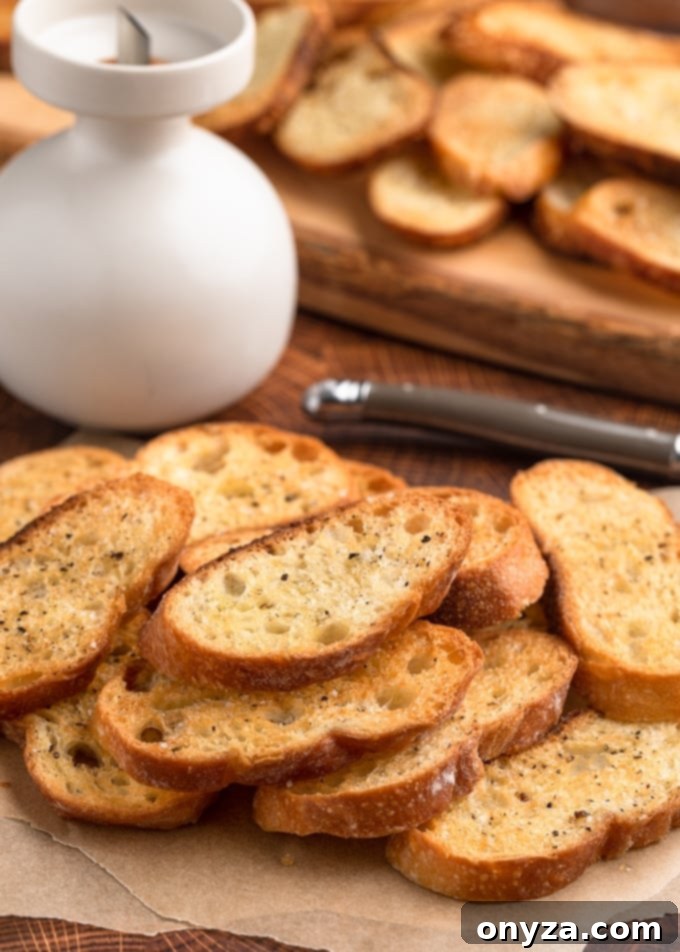
Mastering Homemade Crostini: Your Guide to Perfect Little Toasts
Crostini are more than just toasted bread; they are a delightful invitation to culinary creativity, serving as the foundation for countless appetizers and snacks. Originating from Italy, these “little toasts” (from the Italian word crostino, singular, and crostini, plural, meaning “little crusts”) are simple yet elegant, making them a staple for entertaining, cheese boards, or even a sophisticated snack.
This comprehensive guide will walk you through everything you need to know about making perfect crostini from scratch. From selecting the ideal bread to mastering the art of slicing and baking, we’ll ensure your homemade crostini are consistently golden, crispy, and utterly delicious. Get ready to elevate your entertaining game with these versatile little bites!
What Exactly Are Crostini?
At its heart, a crostino is a small, thinly sliced piece of bread that has been toasted until golden brown and crispy. Traditionally, these toasts are made from a baguette or a similar long, slender loaf of bread, brushed with olive oil and seasoned before baking.
While the term “crostini” can simply refer to these toasted bread slices, it’s more commonly used to describe the assembled antipasto (appetizer) where the crispy toast acts as a base for a myriad of toppings. Think of them as miniature canvases for an array of flavors – from savory cheeses, cured meats, and fresh seafood, to vibrant fruits and earthy vegetables. Their small size makes them perfect for single-bite or two-bite enjoyment, ideal for mingling at parties or as a refined starter to any meal.
Crostini vs. Bruschetta: Understanding the Delicious Distinction
It’s common to find “crostini” and “bruschetta” used interchangeably, as both involve toasted, topped slices of bread. However, these two beloved Italian antipasti possess distinct characteristics rooted in their preparation and cultural origins. Understanding the difference is key to appreciating each for its unique qualities.
The Essence of Crostini
- Bread Type: Crostini are typically made from a French baguette or a narrow Italian loaf. The smaller diameter of these breads yields delicate, bite-sized rounds or ovals.
- Slicing: The bread is sliced thinly, usually between 1/4 and 1/2 inch thick, ensuring a light and crunchy texture once toasted.
- Preparation: Slices are brushed generously with olive oil and often seasoned with salt and pepper before being toasted in the oven until crisp and lightly golden.
- Texture and Size: The result is a small, thin, and consistently crunchy toast, easy to pick up and consume in just a couple of bites. They are designed to be elegant, providing a subtle backdrop for their toppings.
The Robust Character of Bruschetta
- Etymology: The word “bruschetta” originates from the Italian word bruscare, meaning “to roast over coals.” This hints at its rustic, grilled preparation.
- Bread Type: Bruschetta calls for a heartier, wider loaf of rustic Italian bread, such as a country loaf or sourdough. This provides a more substantial base.
- Slicing: Slices are cut thicker than crostini, offering a chewier interior and a more satisfying bite.
- Preparation: The thicker bread slices are traditionally grilled over an open flame or broiled until they achieve a pleasing char and a firm, toasted exterior. After grilling, while still warm, they are often rubbed directly with a raw garlic clove, then drizzled with extra virgin olive oil before being topped.
- Texture and Size: Bruschetta are more substantial, often requiring several bites. Their texture is a delightful contrast of smoky, slightly charred crust and a softer, often garlicky interior. The garlic rub directly onto the warm bread is a hallmark flavor profile of authentic bruschetta.
In essence, crostini are the refined, versatile “little toasts” perfect for delicate toppings, while bruschetta are the rustic, robust “grilled toasts” that celebrate the simple yet powerful flavors of grilled bread, garlic, and olive oil, often paired with more substantial toppings like fresh chopped tomatoes.
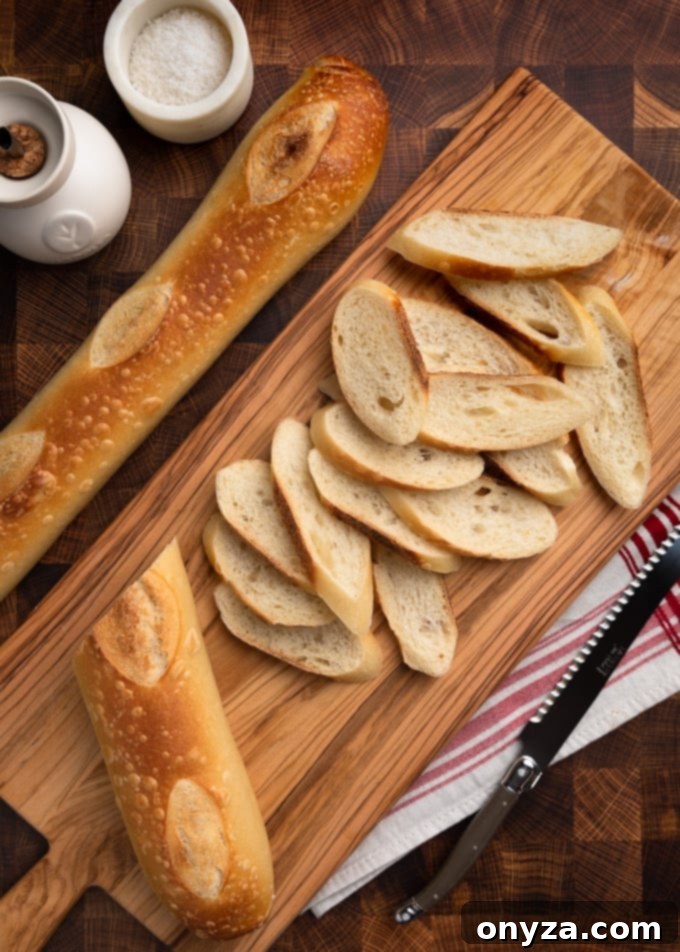
Essential Ingredients for Perfect Crostini
One of the beauties of crostini is their simplicity. With just a few high-quality ingredients, you can create a truly impressive appetizer. Here’s what you’ll need to gather:
- Bread: The Foundation
- Choice: A French baguette is the classic choice, thanks to its narrow shape and crusty exterior. A slender Italian loaf also works wonderfully. Look for bread that isn’t too wide, as you want manageable, bite-sized toasts.
- Fresh or Day-Old: While fresh bread can be used, many culinary enthusiasts, including myself, prefer day-old bread. The slight dryness of day-old bread helps achieve an even crispier texture without becoming excessively hard. It’s also an excellent way to prevent food waste, utilizing leftover loaves from dinner parties or everyday meals.
- What to Avoid: Avoid overly soft or dense breads, as they may not crisp up properly or might become too tough when toasted.
- Olive Oil: The Flavor Enhancer
- Quality Matters: Use good quality extra virgin olive oil. It’s not just a cooking medium; it imparts a significant amount of flavor and helps the bread toast to a beautiful golden brown.
- Purpose: The oil helps create that desirable crisp exterior while preventing the bread from becoming overly dry.
- Salt: The Seasoning
- Type: Kosher salt or a fine-flaked sea salt is ideal. Their crystal structure adheres well to the bread and provides a pleasant burst of seasoning.
- Role: Salt enhances the flavor of the bread itself and provides a subtle base seasoning that complements any toppings you choose to add later.
- Black Pepper: Aromatic Touch
- Freshly Ground: Always opt for freshly ground black pepper. Its aroma and sharp flavor are far superior to pre-ground varieties.
- Complementary: A hint of pepper adds a gentle warmth and complexity that rounds out the basic seasoning.
Feeling Ambitious? Bake Your Own Baguette! For the ultimate homemade experience, consider baking your own baguette. Many excellent recipes are available, such as this one from King Arthur Baking Company.
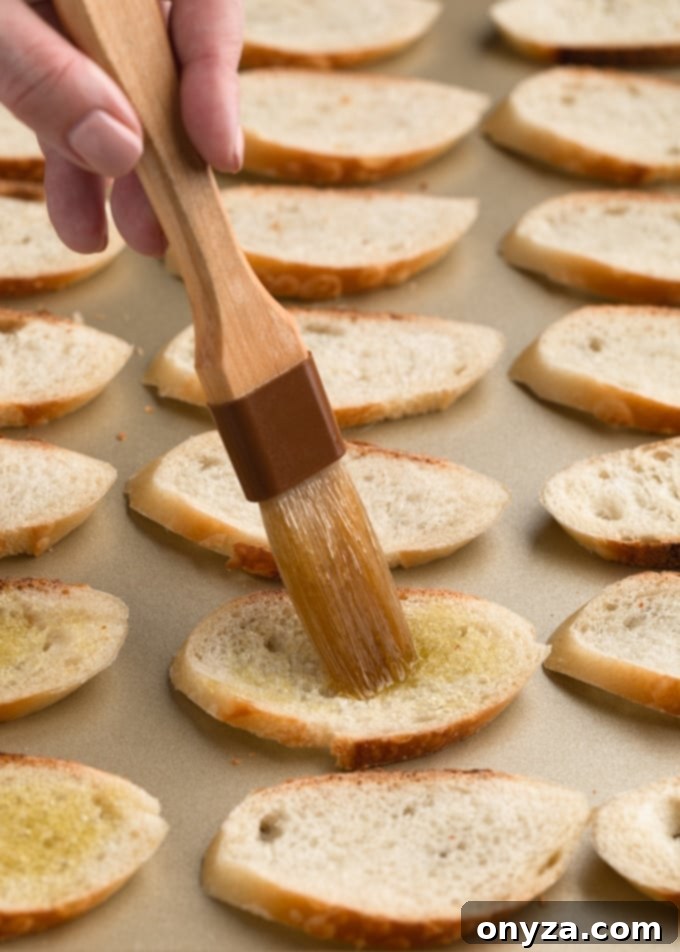
Crafting Perfect Crostini: Step-by-Step Process & Expert Tips
Making crostini is incredibly straightforward, but a few key techniques can elevate your results from good to exceptional. Follow these steps for consistently perfect little toasts:
1. Prepping the Bread: The Art of Slicing
- Preheat Your Oven: Start by preheating your oven to 400°F (200°C). This ensures the oven is at the correct temperature when your bread goes in, leading to even toasting.
- Slice with Precision: Using a sharp serrated knife, slice your baguette into pieces that are 1/4 to 1/2 inch thick. Consistency is paramount here; uneven slices will toast at different rates, leading to some burnt and some undercooked pieces. My personal sweet spot is around 3/8-inch – thin enough for crispness but substantial enough to hold toppings.
- Shape Options:
- Rounds: Simply slice straight across the loaf for classic round crostini.
- Ovals (Diagonal): For a slightly larger, more elegant presentation and increased surface area for toppings, hold your knife at a diagonal angle (as seen in the accompanying photos) to create elongated oval slices.
- Arrange on Baking Sheet: Lay the sliced bread in a single layer on a large baking sheet. For easy cleanup and to prevent sticking, you might line the baking sheet with parchment paper. Ensure the slices are not overlapping or overcrowded, as this can lead to steaming instead of toasting.
- Brush with Olive Oil: Using a pastry brush, lightly brush both sides of each bread slice with olive oil. You want good coverage to help with browning and flavor, but avoid saturating the bread, which can make it greasy or soggy. A thin, even coating is the goal.
- Season Lightly: Season just one side of the oiled bread slices with a sprinkle of kosher or sea salt and freshly ground black pepper. The reason for seasoning only one side, and doing so lightly, is to keep the crostini versatile. This subtle seasoning complements a wide range of toppings without overpowering them. Remember, the toppings will bring their own robust flavors.
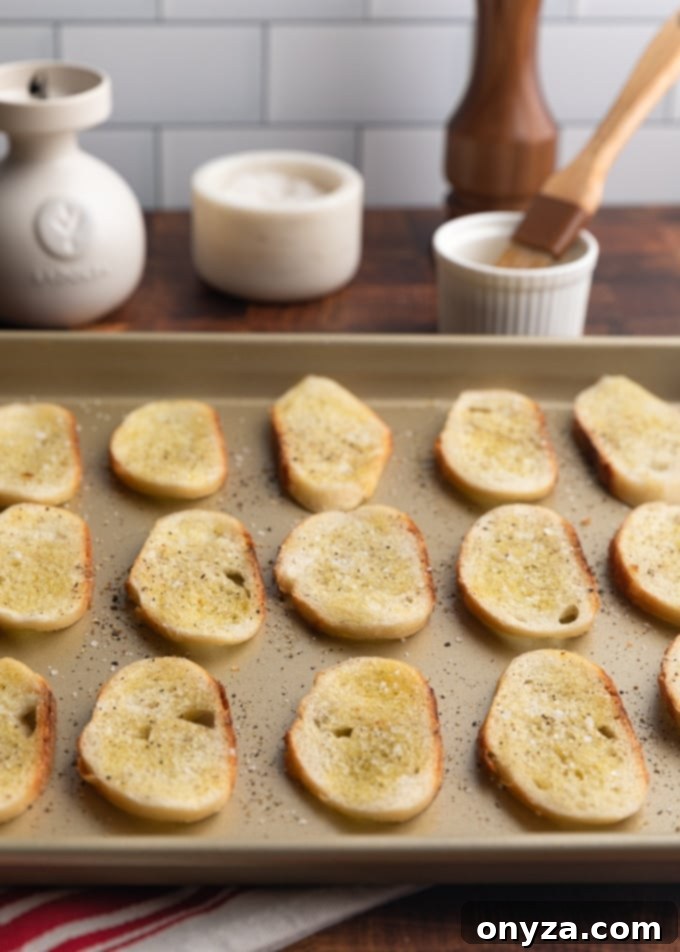
2. Toasting the Crostini to Golden Perfection
The baking process is quick, so vigilance is key to achieving that perfect crispness without burning. Different recipes suggest temperatures ranging from 350°F to 425°F, but I’ve found 400°F (200°C) to be the sweet spot. This temperature is hot enough to toast the bread quickly, creating a beautifully crisp exterior, while ensuring the interior doesn’t become excessively dry or hard to bite once cooled.
- Bake Until Golden: Place the baking sheet with the prepared bread slices into the preheated oven. Bake for 6-8 minutes, flipping the slices halfway through (around the 3-4 minute mark).
- Monitor Closely: Baking time is variable and depends on several factors:
- Bread Thickness: Thicker slices will take longer.
- Bread Density: Some baguettes have a denser crumb and may require a minute or two more.
- Moisture Content: Day-old bread, being drier, typically toasts faster than fresh bread.
Keep a very close eye on your crostini, especially during the last few minutes. Bread can go from perfectly golden to burnt in a matter of seconds. They should be lightly golden brown and crisp to the touch.
- Cool and Crisp: Once toasted to your liking, remove the crostini from the oven and let them cool on the baking sheet for a few minutes before transferring them to a wire rack. Crostini will continue to crisp up as they cool to room temperature.
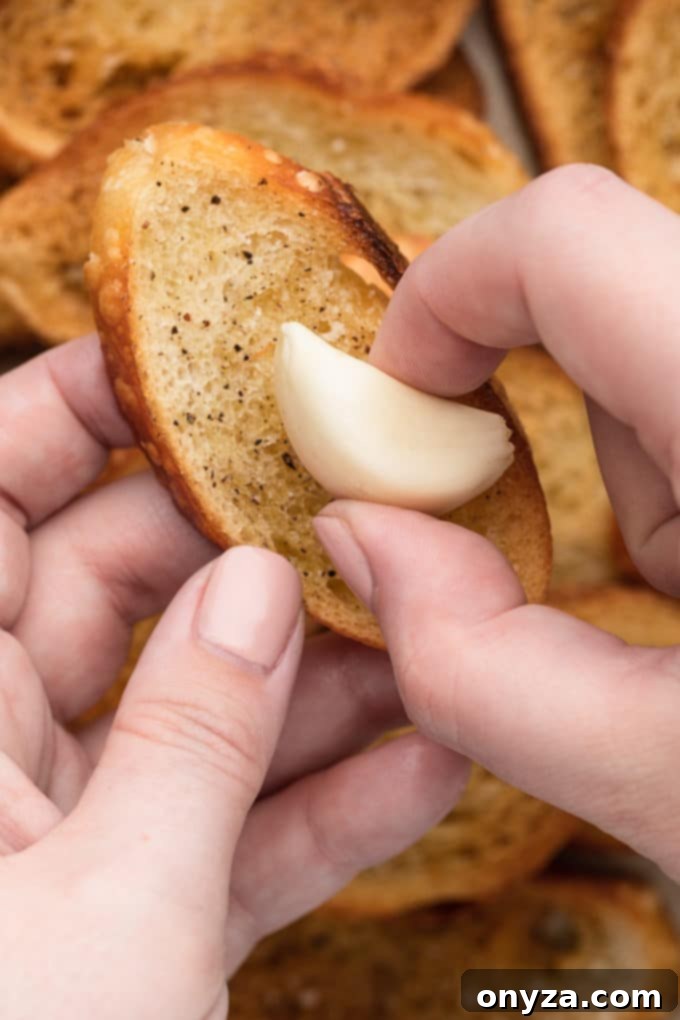
Crostini FAQs: Your Questions Answered
Here are some common questions about making and serving crostini:
Q. How long do homemade crostini stay fresh?
A. Crostini are truly delightful when served warm, straight from the oven. However, once completely cooled, you can store them in an airtight container or a zip-top bag at room temperature for 3 to 5 days. Ensure they are fully cooled before storing to prevent condensation, which can make them soggy. They can also be refreshed in a toaster oven for a few minutes if they lose a little crispness.
Q. Can I add other seasonings or flavors to my crostini?
A. Absolutely! While a basic salt and pepper seasoning offers maximum versatility for various toppings, you have many options to infuse more flavor directly into the toast:
- Garlic Rub: For a delicious burst of garlic flavor, take a cue from bruschetta. While the crostini are still warm from the oven, gently rub one side of each toast with a cut clove of fresh garlic. The warmth of the bread will help release the garlic’s essential oils.
- Herb-Infused Olive Oil: Finely chop your favorite fresh herbs (such as rosemary, thyme, or oregano) and stir them into the olive oil before brushing it onto the bread slices. This adds an aromatic depth.
- Garlic Powder/Onion Powder: A pinch of garlic powder or onion powder can be mixed with the salt and pepper for a savory twist.
- Spice Blends: Experiment with Italian seasoning, red pepper flakes, or even a dash of paprika for different flavor profiles, depending on your planned toppings.
Q. What are some ideal toppings and serving ideas for crostini?
A. The beauty of crostini lies in their versatility. They can be topped with almost anything your heart desires! Here are a few popular and delicious suggestions:
Savory Crostini Ideas:
- Classic Spreads: Serve with a vibrant Black Olive Tapenade, a creamy Roasted Red Pepper Hummus, or a rich pâté.
- Cheese Combinations:
- Whipped goat cheese with roasted red peppers or fig jam.
- Brie and caramelized onions.
- Ricotta with honey and black pepper.
- Blue cheese with sliced pears and walnuts.
- Fresh mozzarella, basil, and cherry tomatoes (Caprese style).
- Meats & Seafood:
- Prosciutto with melon or pesto.
- Smoked salmon with dill cream cheese and capers.
- Salami or soppressata with a dollop of sundried tomato paste.
- Shrimp scampi or garlic shrimp.
- Vegetable & Legume Toppings:
- Sautéed mushrooms with garlic and fresh parsley.
- Artichoke heart dip or a warm spinach and artichoke dip (Spinach and Artichoke Dip, Crab and Artichoke Dip).
- Roasted cherry tomatoes with balsamic glaze.
- White bean dip with fresh rosemary.
Sweet Crostini Ideas:
- Fruit & Cheese: Roasted Grape Crostini with balsamic-roasted grapes and whipped goat cheese is a delightful sweet and savory option.
- Nutella & Berries: A smear of Nutella topped with fresh raspberries or sliced strawberries.
- Honey & Ricotta: Creamy ricotta drizzled with honey and sprinkled with chopped pistachios.
Dipping Companions:
Beyond toppings, crostini are excellent for dipping into warm and cold spreads, such as:
- Various kinds of hummus.
- Creamy spinach or crab dips.
- Marinara sauce for a simple, Italian-inspired snack.
- Warm olive oil infused with herbs and garlic.
Connect with Our Culinary Community! Join our exclusive Facebook group where we share more delicious recipes, expert hosting tips, creative party ideas, and connect with fellow food enthusiasts!

Crostini Recipe
by Amanda Biddle
These crisp toasted bread rounds are an easy recipe to keep on hand for appetizers, cheese boards, and more. Homemade crostini are quick to make and a great way to use up a loaf of day-old bread!
Prep Time: 10 minutes
Cook Time: 8 minutes
Total Time: 18 minutes
Servings: 25 toasts
Ingredients
- 1 baguette or other long, thin, crusty bread (fresh or day-old)
- ½ cup olive oil (more or less, depending on how long the baguette is)
- Kosher or fine-flaked sea salt
- Freshly-ground black pepper
Instructions
- Preheat oven to 400 degrees F. Slice baguette into 1/4 to 1/2 inch thick slices. You can either slice them as rounds or on the diagonal.
- Arrange bread slices in a single layer on a baking sheet. Brush both sides with olive oil. Lightly season one side with salt and pepper.
- Bake 6-8 minutes, flipping once, until bread is crisp and lightly-toasted.* Serve warm or at room temperature with your favorite crostini toppings.
Notes
*Baking time will vary based on the type of bread you’ve used, how thick you’ve sliced it, its moisture content, and density. In general, most will take between 6 and 8 minutes. Keep a close eye on the crostini as they bake so they don’t burn.
See the FAQ’s above for seasoning variations.
Nutrition Estimate
Serving: 1 toast | Calories: 65kcal | Carbohydrates: 5g | Protein: 1g | Fat: 5g | Saturated Fat: 1g | Sodium: 340mg | Potassium: 11mg | Fiber: 1g | Sugar: 1g | Calcium: 8mg | Iron: 1mg
Nutrition information is automatically calculated, so should only be used as an approximation.
About Our Recipes
Please note that our recipes have been developed using the US Customary measurement system and have not been tested for high altitude/elevation cooking and baking.
